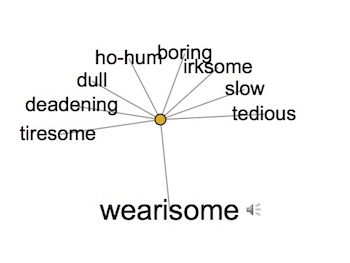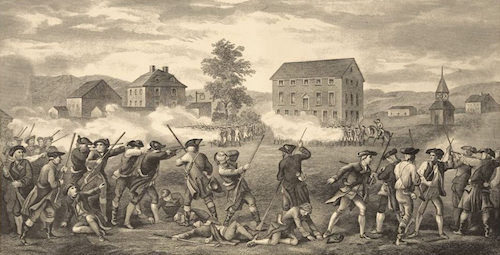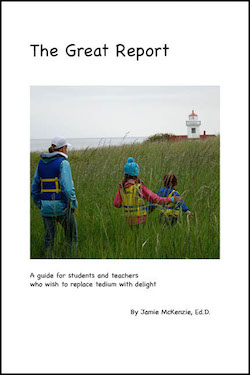Some questions are more powerful, more important and more engaging than others. Some are quite boring. They will cause students to "lose enthusiasm and initiative, especially as a result of a tedious or restrictive routine." (Quoting from the Apple Dictionary's definition of "stultify.")
 Produced at Thesaurus.Com Produced at Thesaurus.Com
The failure to know the difference between compelling and stultifying can undermine the success of even the most ambitious and well intended reform effort.

Imagine two high school students riding home on the bus. They have spent the week wrestling with what their social studies teacher calls a "compelling question."
Was the American Revolution a revolution?
One girl shakes her head and moans in exasperation. "What makes her think this question is compelling?" she says. "Isn't it supposed to be mysterious or intriguing or fascinating to us?"
"I sure don't know," replies her friend. "It's all just hopelessly boring to me. It was obviously a revolution. Why else call it 'the American Revolution?'"
"Yeah," mutters her friend. "Once we say 'Yes!' why do we need to spend a whole week explaining our answer and looking up facts about geography and economics?"
"Beats me!"
Traits of a Compelling Question
Matches student interests, concerns,
fears and wishes |
Awakens interest |
Explores a mystery |
Fascinates |
| Is age appropriate |
Is intriguing |
| Requires more than a "yes" or "no" answer |
Is engaging |
| Requires more than mere fact gathering |
Is baffling |
| Has no "right answer" |
Provokes curiosity |
| Requires synthesis |
Is conceptually rich |
| Has "staying power" |
|
| Explores controversial issues |
|
 © iStock © iStock
Good intentions are not enough
In 2013, the NCSS (National Council of the Social Studies) approved the “C3 Framework" (College, Career, and Civic Life (C3) Framework for Social Studies State Standards), promoting the use of Compelling Questions along with what they called Supporting Questions.
NOW MORE THAN EVER, students need the intellectual power to recognize societal problems; ask good questions and develop robust investigations into them; consider possible solutions and consequences; separate evidence-based claims from parochial opinions; and communicate and act upon what they learn. And most importantly, they must possess the capability and commitment to repeat that process as long as is necessary. Young people need strong tools for, and methods of, clear and disciplined thinking in order to traverse successfully the worlds of college, career, and civic life. Page 6
On first reading, the document seems promising, but there is a danger that questions being offered by some as "compelling" fall short of the definition offered by the authors of the “C3 Framework" and are neither compelling nor engaging, but are, in fact, nothing more than hunting and gathering exercises that amount to trivial pursuit.
Compelling questions focus on enduring issues and concerns. They deal with curiosities about how things work; interpretations and applications of disciplinary concepts; and unresolved issues that require students to construct arguments in response. Page 23
 © iStock © iStock
What is a compelling question for a ten year-old,
thirteen year-old or seventeen year-0ld?
Some of the questions adults consider compelling and write into curriculum documents, a ten year old will find stultifying.
To be compelling for a ten year old, the question must match, awaken or startle the interests, fears, dreams, wishes and concerns of that young boy or girl.
 © iStock © iStock
A really good question will keep the kid up at night, will linger in the background during the day and cause some productive daydreaming.
It is the same with each age level. To write compelling questions related to social studies, the adult must understand children at each age and their passions.
 © iStock © iStock
Alternatively, the classroom teacher must engage the students in formulating the questions. Unfortunately, most school questions tend to require nothing more than factual recall or fact gathering. Given a chance to pose questions about the "Great Wall of China," for example, students will tend to ask how long it was, how long it took to build and how much it cost, unless they have been given training in posing different kinds of questions.
The C3 document mentions the importance of students learning to pose questions but provides little guidance.
"Filling the Tool Box: Classroom Strategies to Engender Student Questioning" does just that, with one activity being especially pertinent and valuable: "Class Taxonomy of Questions" shows how to strengthen the capacity of students to pose questions that require thought, imagination, and synthesis, questions that require more than mere "scooping" and gathering of facts, questions that flow from their passions, interests and curiosity.
Rate these questions!
Some of the states have published lists of what they consider to be compelling questions to accompany their social studies standards and content.
Take a look at these examples from Kansas and Connecticut. Would sixth grade or high school students find them compelling?
Rate each question on a scale from -5 (stultifying) to +5 (compelling)
Kansas 6th Grade Compelling Questions
- Why did Siddhartha Gautama decide to leave his home and what was the result of that decision?
- How did Hammurabi’s Code affect the rights and responsibilities of the citizens of Babylon?
- How did the beliefs of Brahmanism and Hinduism impact Indian society?
- What are some of the differences between the Shang, and Zhou dynasties?
- How did geography influence the development of early river civilizations?
- How did Rome’s expansion affect trade?
- How did changing views on freedom of worship in the Roman Empire affect the spread of Christianity?
- What ideas from the government in the Roman Republic influenced the government of the United States?
- How do Roman accomplishments continue to impact our lives today?
- How did Rome’s location on the Mediterranean affect its growth into a world power?
Source: Kansas State Standards - Sixth Grade Social Studies
|
Kansas World History Compelling Questions
-
What choices made by the Church led to the Protestant Reformation and why?
- By what authority and with what kind of power did the Catholic Church fight against the heresy of the Reformation?
- How was the world changed by the ideas of the Renaissance and/or Reformation?
- Did the Renaissance and Reformation give birth to the modern western world?
- What influence did the Renaissance have on the Reformation?
- What were the critical factors to be considered when planning a voyage of exploration?
- How did exploration and expansion affect the rights and responsibilities of people?
- How did ideas about isolationism and expansionism affect nations and history?
- How did the cultural interaction and diffusion of the period impact various global regions?
- What kind of geographic factors impact exploration and expansion?
Source: Kansas State Standards - High School World History
|
Connecticut World History Compelling Questions and Supporting Questions
- What makes the world modern?
- How have attempts at resolving conflicts created further problems?
- In what ways do personal and cultural experiences shape perspectives?
- How do people and nations seek and react to change?
- What is the proper balance between the rights of the individual and the power of government?
- To what extent is the international community responsible for the protection of human rights?
- What is the relationship between a nation’s economic interests and its foreign policy?
- Has globalization and international trade led to greater cooperation or conflict in the world?
- Where and why have human cultural traits and ideas diffused across the globe?
- Compelling Question:
How is the evolution of Communism over time reflected in various historical sources?
Supporting Questions:
How do 19th- and 20th-century sources view Communism differently?
How is Communism viewed from both western and non-Western perspectives?
How does the Communist Manifesto represent a response to the Industrial Revolution?
How do various sources account for the apparent failure of Communism; did the end of the Cold War
indicate that Communism had failed?
How do contemporary sources view the basic ideas of Communism?
- Compelling Question: What is modernization and globalization? Are they connected?
Supporting Questions:
How do geographic representations help illustrate the modern world?
How does your global address determine perspective of modernization?
Has globalization affected perspective?
Is modernization advancement?
- Compelling Question: In what ways have the political and social structures of Latin America lead to patterns of human
development, exploration, and/or conflict?
Supporting Questions:
How did the quests for independence affect the region and alter regional identity?
How did the social structures imposed through colonial control affect land use?
How have varying economic interests affected land use and development?
How do economic decisions have both long-term and short-term impacts on environment and culture?
- Compelling Question: During the era of the Industrial Revolution, how did economic decisions affect changes in population
distribution?
Supporting Questions:
What was occurring in the rural areas to allow people to relocate to the cities?
How did urban planning change as populations increased?
How has modern economic and industrial development fostered movement from place to place?
Source: Connecticut Social Studies Frameworks | HIGH SCHOOL — MODERN WORLD HISTORY
|
Writing better questions for social studies
We owe a debt of gratitude to the late Grant Wiggins for inventing what we now call Essential Questions back in the 1980s. Such questions have stood for decades at the pinnacle of the questioning hierarchy, but for some reason, the authors of the “C3 Framework" made no mention of such questions which were designed with K-12 students in mind and would have greatly improved the document. They also ignored what I call Questions of Import.
Those who are charged with implementing the “C3 Framework" will find both of these question types very helpful when trying to draft questions that 10 year-olds, 13 year-olds and 17 year-olds might find fascinating, engaging and actually compelling.
|

 Produced at Thesaurus.Com
Produced at Thesaurus.Com

 © iStock
© iStock
 © iStock
© iStock
 © iStock
© iStock
 © iStock
© iStock
